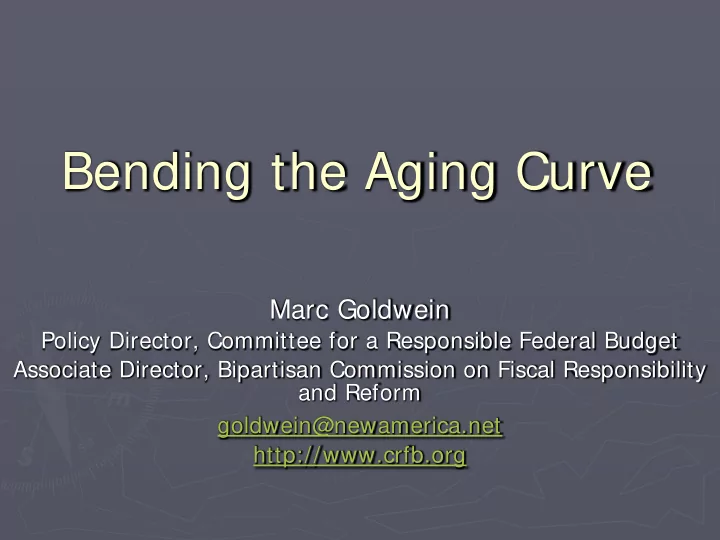

Bending the Aging Curve Marc Goldwein Policy Director, Committee for a Responsible Federal Budget Associate Director, Bipartisan Commission on Fiscal Responsibility and Reform goldwein@newamerica.net http://www.crfb.org
Looming Insolvency Social Security Revenues and Costs (percent of payroll) 20% Histor orical al Proj ojections ons 18% 16% 14% 12% 10% 8% 6% 1970 1974 1978 1982 1986 1990 1994 1998 2002 2006 2010 2014 2018 2022 2026 2030 2034 2038 2042 2046 2050 2054 2058 2062 2066 2070 2074 2078 2082 Source: Committee for a Responsible Federal Budget and Social Security 2009 Trustees Report
Growing Levels of Debt Current Policy Debt Levels Current Law Debt Levels
Caused by Growing Entitlement Costs
Driven by Health Care and Aging Source: Committee for a Responsible Federal Budget and Congressional Budget Office
Other Consequences of Aging ► Slower Economic Growth Fewer Workers Fewer Investors ► Greater Risk of Poverty in Old-Age More years in retirement Higher chance of outliving savings ► Fiscal Insolvency More Entitlement Costs Less Revenue
We Can Bend the Aging Curve
The Dependency Ratio
Change the Demographics
Make Retirees Less Dependent
Make Workers Wealthier
Change the Equation
Mitigating the Effects of Aging? ► Increase Mortality ► Increase Fertility ► Increase Immigration ► Encourage Longer Working Lives ► Increase National (and Personal) Savings ► Improve Economic Growth
Benefits of Later Retirement Percent of Percent deficit ► Lower Social Security Costs Policy 75-year gap closed in 75th closed year (or larger annual benefits) Raise Normal Retirement 23% 17% Age (NRA) to 68 ► Higher Payroll Tax Revenues Index EEA and NRA to Life 28% 28% Expectancy ► Higher Income Tax Revenue Increase Computations 15% 10% Years to 38 ► Greater Retiree Wealth Modify Early/Late 15% 5% Retirement ► Fewer Years of Reliance on Penalties/Bonuses Wealth by Retirees Exempt Workers with 45 -7% -4% Years of Work from Their Half of Payroll Tax ► Stronger Economic Growth
We Can Do It 90 Social Security Medicare Act Passed 85 Established 80 75 70 16 Years 6 Years 65 60 Normal 55 Early Retirement Age Retirement Age (62) Established for all Increase Begins 50 Beneficiaries 45 40 9 2 5 8 1 4 7 0 3 6 9 2 5 8 1 4 7 0 3 6 9 2 5 8 1 4 7 2 3 3 3 4 4 4 5 5 5 5 6 6 6 7 7 7 8 8 8 8 9 9 9 0 0 0 9 9 9 9 9 9 9 9 9 9 9 9 9 9 9 9 9 9 9 9 9 9 9 9 0 0 0 1 1 1 1 1 1 1 1 1 1 1 1 1 1 1 1 1 1 1 1 1 1 1 1 2 2 2 Average Life Expect ancy at Birt h Average Ret irement Age
Increasing National and Personal Savings Through Add-On Accounts ► Greater Retirement Security (especially in light of benefit cuts) ► Increased Availability of Safe and Low-Cost Investments ► Better “Pre-Funding” of Retirement Benefits ► Stronger Economic Growth
Saving 2% of Income $250,000 Cumulative Contributions at Age 67: $43,135 Value of Savings Account at Age 67: $231,132 $200,000 $150,000 Size of Account $100,000 Total Contribution $50,000 $0 22 24 26 28 30 32 34 36 38 40 42 44 46 48 50 52 54 56 58 60 62 64 66 Based on data produced by bankrate.com’s 401(k) retirement calculator
Returns to Accounts After a Market Crash Average Change in Total Benefits Source: Andrew Biggs, American Enterprise Institute
Making Hard Choices Percent of Percent Percent of 75- Percent deficit Policy 75-year gap deficit closed Policy year gap closed in 75th closed in 75th year closed year Immediately Cut Immediately Raise Payroll 31% 19% 50% 25% All Future Benefits by 5% Tax by 1% Slow the Growth of Initial Raise Taxable Maximum to 31% 36% 37% 14% Benefits for Higher Earners Cover 90% of Earnings Slow the Growth of Initial 66% 91% 95% 38% Benefits for High and Medium Eliminate Taxable Maximum Earners Apply Payroll Tax to Index Benefits to a Slower 57% 22% 25% 16% Employer-Provided Health Measure of Inflation Care Benefits Impose 3% Surtax on Apply Progressive Benefit 19% 10% Payroll Income Above 21% 19% Formula Based on Annual $200,000 Rather than Lifetime Wages Source: Committee for a Responsible Federal Budget and Social Security Administration Actuaries
Bending the Aging Curve Marc Goldwein Policy Director, Committee for a Responsible Federal Budget Associate Director, Bipartisan Commission on Fiscal Responsibility and Reform goldwein@newamerica.net http://www.crfb.org
Recommend
More recommend